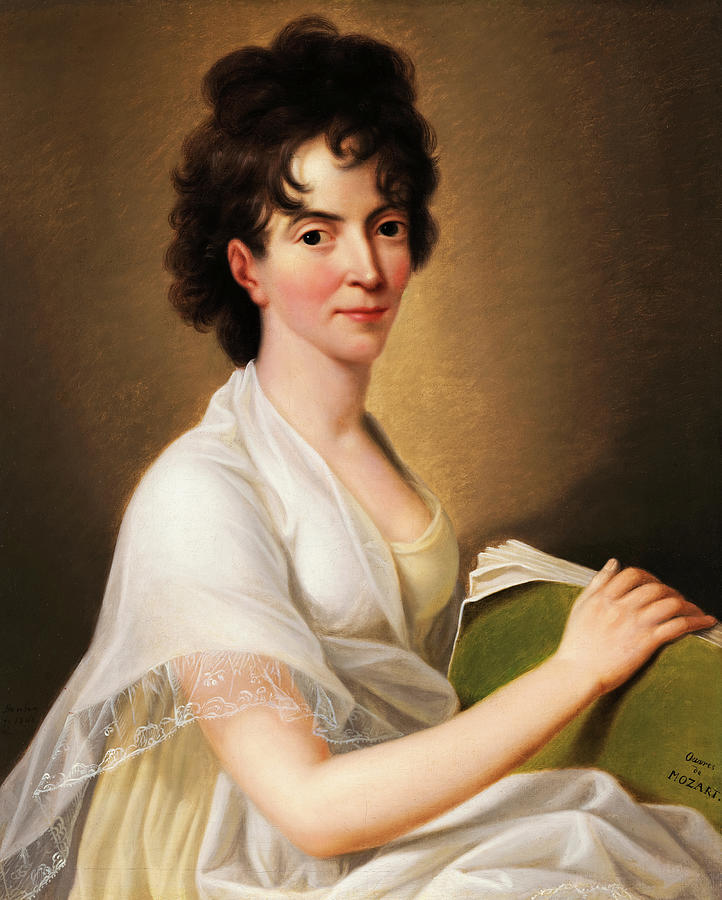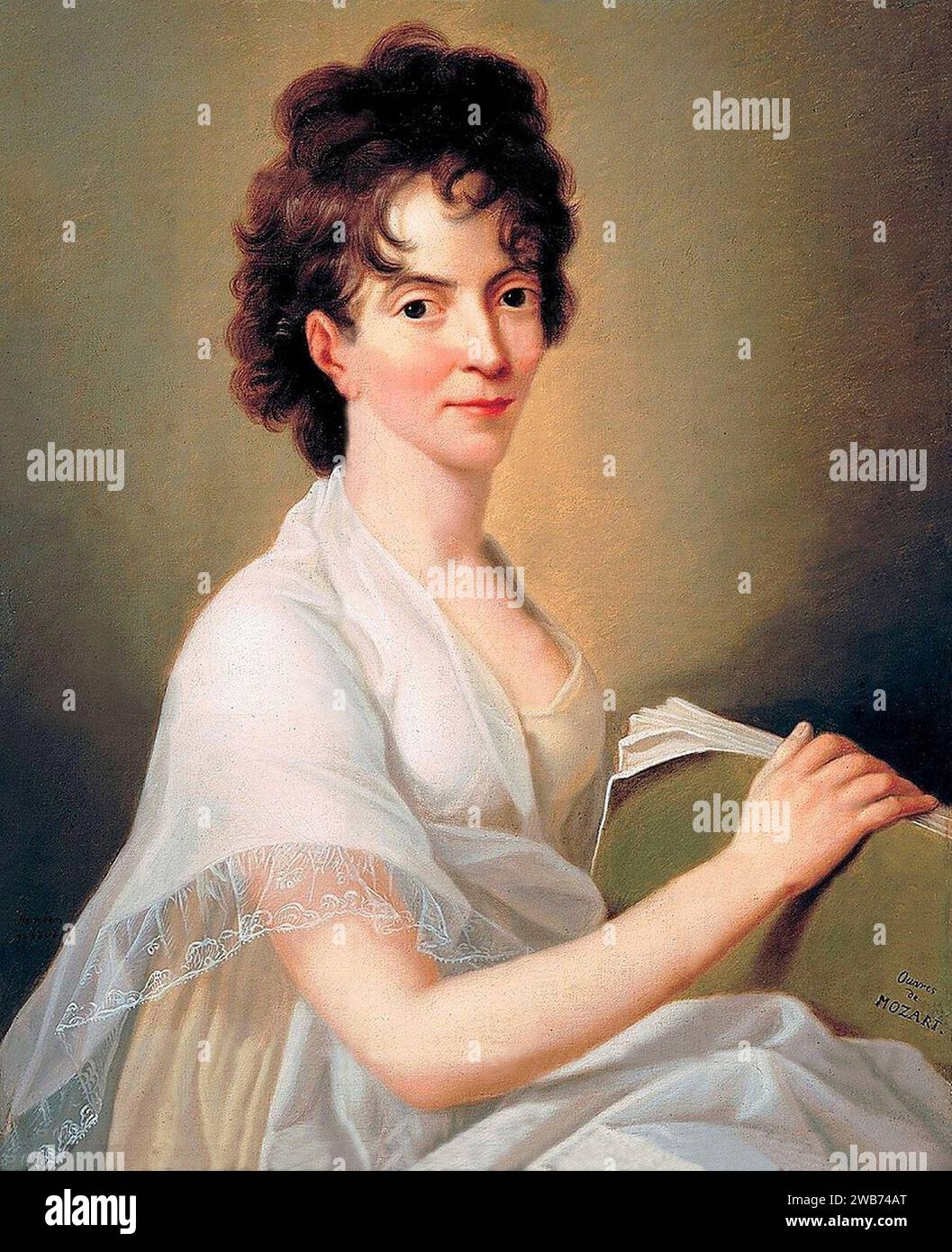Was Constanze Mozart merely a footnote in the grand symphony of Wolfgang Amadeus Mozart's life, or was she a composer in her own right, orchestrating the survival of his legacy against considerable odds? It's time to delve into the life of this remarkable woman, often overshadowed by her more famous husband, and discover the strength, resilience, and business acumen that defined her.
Constanze Mozart, born Maria Constanze Ccilia Josepha Johanna Aloisia Weber, was far more than just the wife of a genius. She was a German soprano, a savvy businesswoman, and a devoted mother who, after Mozart's untimely death, took on the Herculean task of ensuring his music lived on. Her story is one of love, loss, and ultimately, triumph over adversity, as she navigated the complex world of 18th and 19th-century Europe to safeguard her husband's artistic heritage.
| Category | Information |
|---|---|
| Birth Name | Maria Constanze Ccilia Josepha Johanna Aloisia Weber |
| Birth Date | January 5, 1762 (or possibly January 6, 1763) |
| Birth Place | Zell im Wiesental, Black Forest, Germany (or possibly Freiburg im Breisgau) |
| Death Date | March 6, 1842 |
| Death Place | Salzburg, Austria |
| Nationality | German |
| Occupation | Soprano Singer |
| Spouses | Wolfgang Amadeus Mozart (m. 1782, d. 1791), Georg Nikolaus von Nissen (m. 1809) |
| Children | 6 with Mozart (only 2 survived infancy: Karl Thomas Mozart and Franz Xaver Wolfgang Mozart) |
| Parents | Franz Fridolin Weber and Maria Ccilia Cordula Stamm |
| Siblings | Aloysia Weber (also a soprano), Josepha Weber (soprano), Sophie Weber |
| Key Accomplishments | Preserved and promoted Mozart's music after his death, commissioned and contributed to his biography, supported her family financially. |
| Reference Link | Encyclopdia Britannica - Constanze Mozart |
Theirs was a whirlwind romance that defied convention. Mozart's initial attraction was to Constanze's older sister, Aloysia, a talented soprano. However, his affections soon shifted to Constanze. The Weber family was a musical one; her father, Franz Fridolin Weber, worked as a bass player and prompter. When Mozart encountered the Webers again in Vienna in 1781, Aloysia was already married. The stage was set for a new chapter, one that would intertwine the lives of Wolfgang and Constanze.
- New Web Series Movies What To Watch Date Streaming Guide
- Nsfw 18 Content What You Need To Know 2024 Guide
Their courtship wasn't without its obstacles. Mozart's father, Leopold, was vehemently opposed to the match. He viewed the Weber family as unsuitable and feared that marriage would distract his son from his musical pursuits. Despite Leopold's disapproval, Wolfgang and Constanze were determined to be together. They exchanged vows in St. Stephen's Cathedral in Vienna on August 4, 1782, the Feast of the Assumption. This act of defiance against paternal authority underscored the depth of their commitment to one another.
Constanze's influence on Mozart's work is a subject of much debate among scholars. Some argue that she was a muse, inspiring his compositions, particularly "The Abduction from the Seraglio." Others contend that her role was more practical, providing emotional support and a stable home life that allowed him to focus on his music. Regardless of the extent of her direct artistic contribution, it is undeniable that Constanze provided a crucial anchor for Mozart during a period of intense creativity and personal turmoil.
The early years of their marriage were marked by both joy and hardship. They had six children, but only two, Karl Thomas Mozart and Franz Xaver Wolfgang Mozart, survived infancy. The financial strain of supporting a family, coupled with Mozart's extravagant spending habits, often left them in precarious circumstances. Yet, through it all, Constanze remained a steadfast presence, managing the household and providing a loving environment for her husband and children.
Mozarts physical appearance, as described by Constanze and other contemporaries like his sister Nannerl and colleague Michael Kelly, painted a picture of a man of small stature, possessing a thin frame and a pale complexion. These shared observations offer a glimpse into the physical reality of the musical genius, grounding the legend in tangible details.
The year 1791 brought unimaginable tragedy. Mozart, at the age of 35, succumbed to illness, leaving Constanze a widow with two young children and a mountain of debt. The circumstances surrounding his death remain shrouded in mystery and speculation, fueling countless conspiracy theories. What is certain is that Constanze faced a daunting future, one filled with uncertainty and financial insecurity.
However, Constanze Mozart was not one to be easily defeated. At the young age of 29, she displayed remarkable resilience and determination. She understood the value of her late husband's work and recognized the importance of preserving his legacy. With limited resources and two sons to raise, she embarked on a mission to promote Mozart's music and secure her family's future.
One of Constanze's first actions was to organize memorial concerts featuring Mozart's compositions. These performances not only generated much-needed income but also served to keep his name alive in the public consciousness. She also began the arduous task of cataloging and selling his manuscripts, navigating the complex world of music publishing with remarkable savvy.
Constanze's efforts extended beyond mere preservation. She actively sought to shape Mozart's posthumous image, commissioning a biography of her late husband. This biography, initially begun by Franz Xaver Niemetschek and later completed by her second husband, Georg Nikolaus von Nissen, played a crucial role in establishing Mozart as a towering figure in the history of classical music. Max Keller, a family friend from her second marriage to Nissen, also contributed to this effort.
Her relationship with Georg Nikolaus von Nissen proved to be a turning point in her life. Nissen, a Danish diplomat and writer, shared Constanze's passion for Mozart's music and dedicated himself to preserving his legacy. They married in 1809 and worked together to complete the biography, providing invaluable insights into Mozart's life and personality. It is thanks to Nissen that Mozart's reputation was kept alive throughout the 19th century.
Constanze's dedication to her husband's music extended beyond the biography. She meticulously collected and preserved his letters, manuscripts, and other personal effects, creating an invaluable archive for future generations of scholars and music lovers. Her efforts ensured that Mozart's work would be accessible and appreciated for centuries to come.
Despite the challenges she faced, Constanze managed to build a comfortable life for herself and her sons. She leveraged her knowledge of music and her business acumen to secure their financial future. She organized concerts, sold manuscripts, and managed Mozart's estate with remarkable skill.
Constanze's relationship with her sons, Karl Thomas and Franz Xaver Wolfgang, was complex. She undoubtedly loved them and wanted the best for them, but she also recognized their limitations. Neither son inherited their father's extraordinary musical talent. Karl Thomas pursued a career in civil service, while Franz Xaver Wolfgang became a composer and pianist, though he never achieved the same level of fame as his father.
The love story of Wolfgang Amadeus Mozart and Constanze Weber, who married in 1782 despite his father's opposition, is a testament to their deep connection. Mozart found inspiration in Constanze, their six children, and her second marriage to Georg Nikolaus von Nissen. Their relationship, though fraught with challenges, was a source of strength and creativity for the composer.
After Mozart's death, Constanze, then 29, took responsibility for all the family's debts. With little money, she and her two sons lived with her family. However, friends and others provided assistance. She received a small annual pension from the Holy Roman Emperor Leopold II, a family friend financed her sons' education, and Mozart's friends and fans organized a benefit concert to support her.
Constanze's role in Mozart's life and legacy cannot be overstated. She was not merely a wife and mother; she was a partner, a supporter, and a champion of his music. Her unwavering dedication ensured that his genius would be recognized and celebrated long after his death. Mozart's inspiration from her, their children, and her life choices following his death, all contributed to the enduring appeal of his work.
Constanze Mozart, ne Weber, was born on January 5, 1762, in Zell im Wiesental, Black Forest. She passed away on March 6, 1842, in Salzburg. In her first marriage, she was the wife of Wolfgang Amadeus Mozart, and in her second marriage, she was married to Georg Nicolai Nissen. Maria Constanze Ccilia Josepha Johanna Aloisia Mozart (born Weber) later married Georg Nikolaus von Nissen.
Her mother was Ccilia Weber, ne Stamm. Constanze was the third of four daughters of Franz Fridolin Weber and Maria Ccilia Cordula Stamm. From July 1764, the family lived in Mannheim, where her father worked as a bass player and music copyist at the theater, and her second oldest sister, Aloysia, was a coloratura soprano.
When Mozart died at the age of 35, he left his wife Constanze and two children with almost no money and just his papers. Constanze was determined to preserve her deceased husbands memory and music, building a life for herself by organizing memorial concerts and publishing his works, eventually doing quite well for herself financially.
The exact date of Mozart and his first wife's marriage is debated, with some sources citing April 15, Mozarts birthday. However, it is generally accepted that Wolfgang Amadeus and Constanze Weber were married in St. Stephens Cathedral in Vienna on Sunday, August 4, 1782, on the Feast of the Assumption.
When Mozart met the Weber family again in Vienna in 1781, Aloysia was already married. Constanze was only 29 when Mozart died in 1791, leaving her deeply in debt and with two small children. She lived over 50 years after Mozart's death, reaching the age of 80, while Mozart died relatively young in his mid-30s.
Joseph Lange painted a portrait of Constanze Mozart in 1782. A daguerreotype of Constanze Mozart (1840) shows her at age 78, dressed in black, and another image depicts her in 1802. She was born in Zell im Wiesental.
The story of how Mozart met his wife, Constanze, and how she may have appeared in one of his greatest operas adds another layer to their fascinating relationship. Whether muse or manager, Constanze Mozart remains a pivotal figure in the Mozart narrative, a woman whose life deserves to be celebrated in its own right.
- Adam Garcia From Stage To Screen What You Need To Know
- Mustsee Indian Erotic Web Series Your Ultimate Guide


